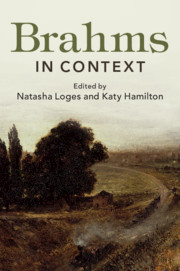Book contents
- Brahms in Context
- Brahms in Context
- Copyright page
- Dedication
- Contents
- Illustrations
- Music Examples
- Notes on Contributors
- Preface
- Abbreviations
- Part I Personality, People and Places
- Part II Identities, Environments and Influences
- Part III Performance and Publishing
- Part IV Society and Culture
- Part V Reception and Legacy
- Further Reading
- Index
- References
Part II - Identities, Environments and Influences
Published online by Cambridge University Press: 15 May 2019
- Brahms in Context
- Brahms in Context
- Copyright page
- Dedication
- Contents
- Illustrations
- Music Examples
- Notes on Contributors
- Preface
- Abbreviations
- Part I Personality, People and Places
- Part II Identities, Environments and Influences
- Part III Performance and Publishing
- Part IV Society and Culture
- Part V Reception and Legacy
- Further Reading
- Index
- References
Summary
During his lifetime, Brahms accumulated a sizeable fortune. Although the early days were not without difficulties, his finances then accumulated steadily and virtually uninterruptedly. When he died in 1897, he left behind not only manuscripts of his own works, but also an extensive collection of other composers’ autograph manuscripts (including of Mozart, Haydn, Beethoven, Schubert, Schumann, etc.) as well as bonds worth over 181,000 Gulden.The size of the sum is evident when one compares the rent that he paid his landlady Coelestine Truxa between 1887 and 1897 for his three-room apartment in Vienna’s Karlsgasse, which amounted half-yearly to 347 Gulden and 25 Kreuzer.
Brahms grew up in the Hamburg‘Gängeviertel’, an area of workers, small-scale artisans and tradesmen in modest circumstances [see Ch. 1 ‘Childhood in Hamburg’]. Later on, when he could determine his own lifestyle, luxury still held no appeal.
Keywords
- Type
- Chapter
- Information
- Brahms in Context , pp. 69 - 184Publisher: Cambridge University PressPrint publication year: 2019

